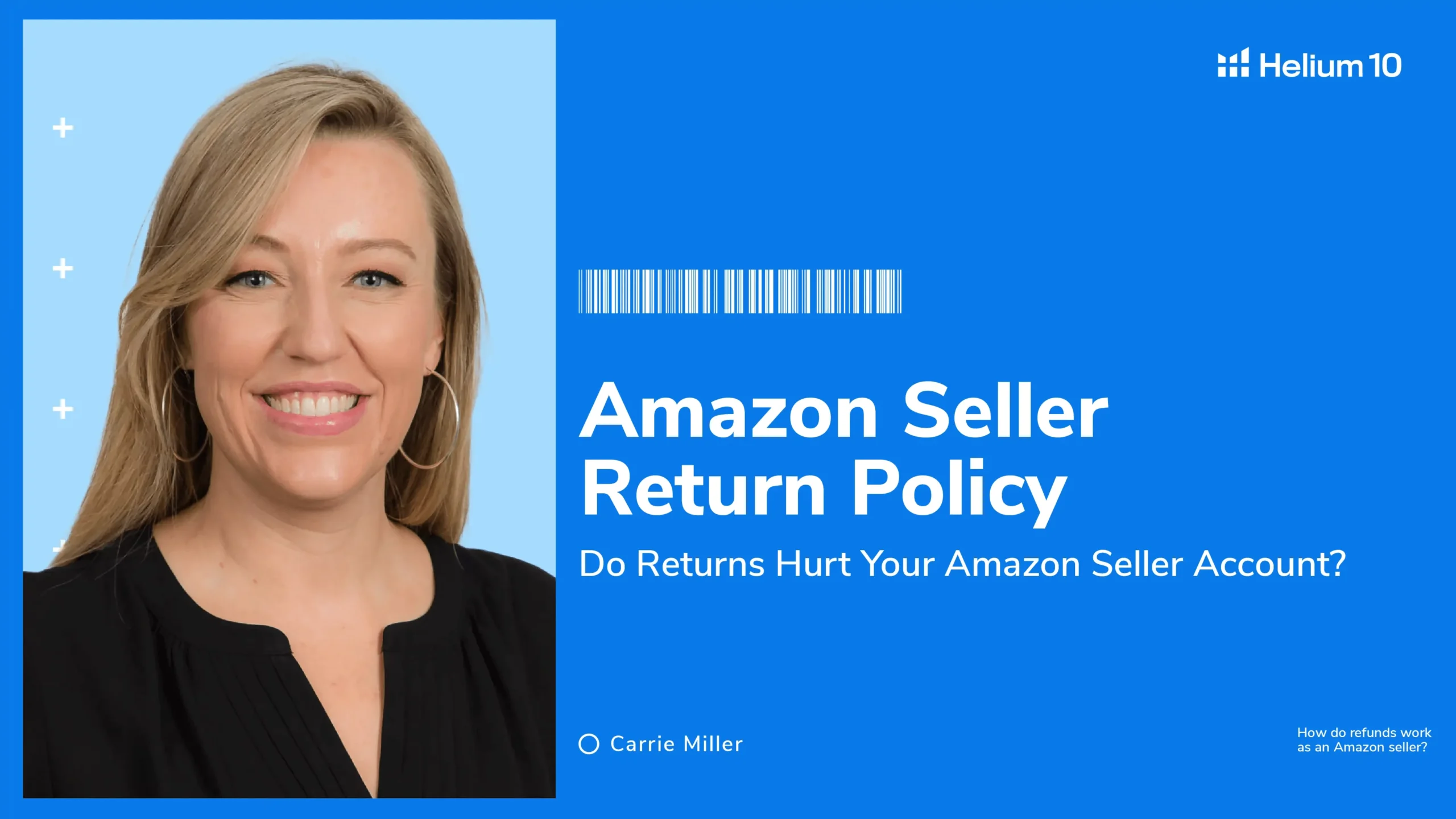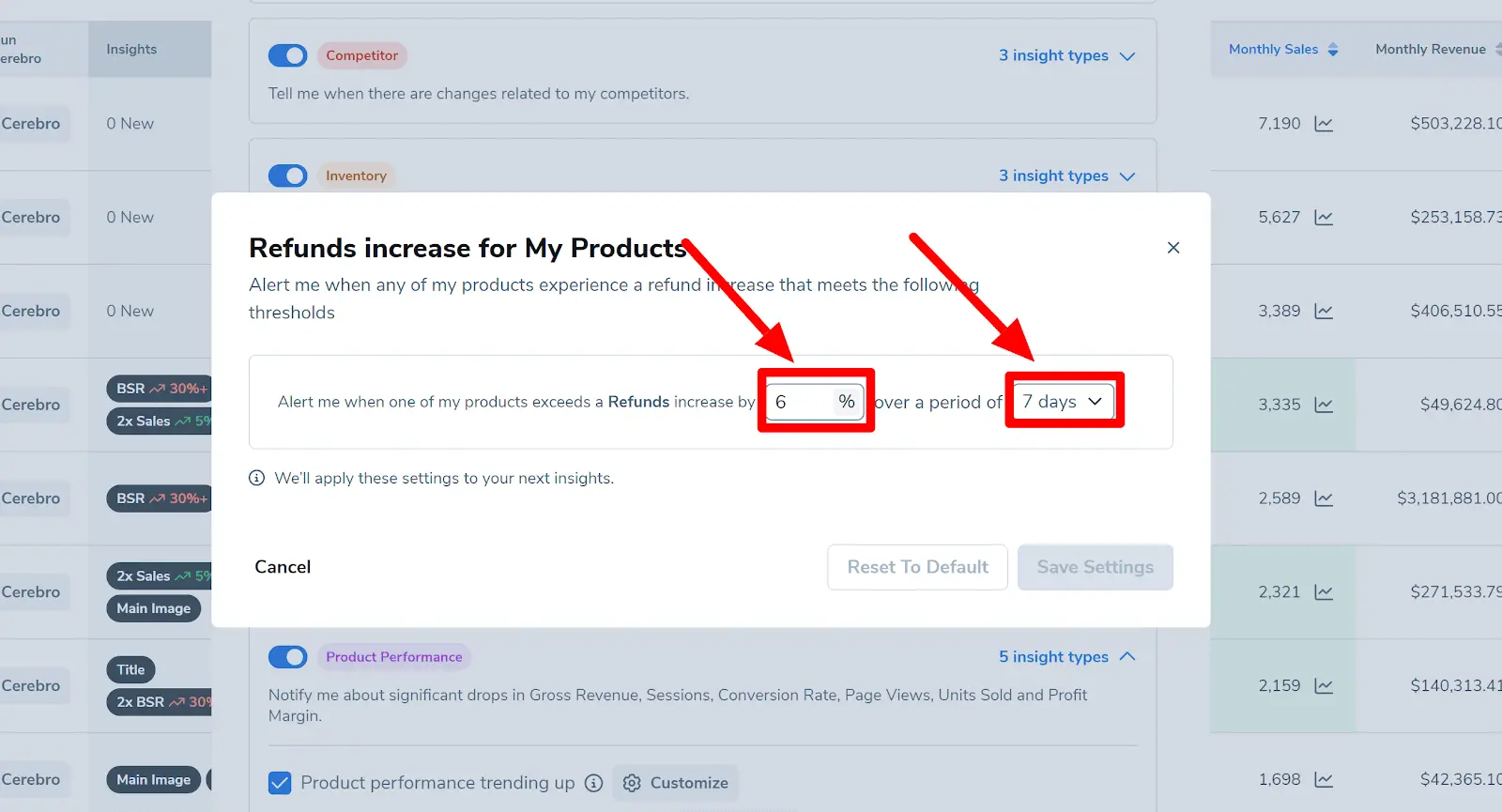
Amazon Seller Return Policy in 2024


Table of Contents
- Introduction
- What Is Amazon’s Seller Return Policy for Sellers?
- How Do Refunds Work as an Amazon Seller?
- Do Amazon Sellers Have to Accept Returns?
- Do Customers Abuse Amazon Returns?
- Which Items Can You Refuse to Be Returned?
- What If the Buyer Doesn't Return the Product?
- Do Returns Hurt Your Amazon Seller Account?
- Differences in the Amazon Return Process for FBA & Non-FBA
- FBA
- Non-FBA (Individual Seller/FBM)
- How Do I Protect Myself From Amazon Return Scammers?
- How Do I Handle Taxes on Refunds?
- What Should I Do With Returned Products?
- What Is the Restocking Fee?
- How Much Does Amazon Charge Sellers (In Total) For Returns?
- Conclusion
Introduction
One of the not-so-fun parts about being an Amazon seller is dealing with Amazon return policies, refund processes, and customer interactions. In this blog, we will explain Amazon’s return policies, refund processes, handling customer abuse, and the strategic management of returned products. From understanding return policies to safeguarding against scams, the following information will give Amazon sellers the knowledge needed to deal with customer returns.
What Is Amazon’s Seller Return Policy for Sellers?
The Amazon return policy for sellers allows customers to return items shipped from Amazon.com, including those from Amazon Warehouse, within 30 days of delivery, with certain exceptions outlined in their “Items that Can’t be Returned” guide. The return timeline for products sold by Amazon may vary, and customers are advised to check the specific product type for any extended return policies. If a seller’s listing is eligible for Amazon Prime, it adheres to the same return policies as items fulfilled by Amazon.
Additional information on refund timing, amounts, partial refunds, restocking fees, and the process for mistaken returns is available in the “Refunds” and “Mistaken Returns” sections. Customers who have already received a refund but are expected to return the item can create a return request. It’s emphasized that failure to send back an item expected to be returned may result in charges. Conversely, if an item has already been returned, any charges incurred will be reversed upon the completion of the return process, with potential delays depending on the financial institution’s processing time.
How Do Refunds Work as an Amazon Seller?
The Amazon seller return policy involves two main scenarios: when a product is returned, or when you opt for a returnless refund, allowing the buyer to keep the product. It is crucial to issue a refund promptly, ideally within two business days of receiving a return. Failure to do so may lead Amazon to intervene, refund the buyer, and charge the amount to your seller account.
Before issuing a refund for a return request, sellers are advised to wait until they receive the item back from the buyer. However, in cases where the buyer is allowed to keep or discard the item, the refund can be issued without waiting for the return. If the returned item is damaged or in a different condition than when sent, sellers have the option to issue a partial refund. It’s recommended to communicate this decision to the buyer in advance to avoid misunderstandings or potential A-to-Z Guarantee claims. Additionally, sellers may issue partial refunds for reasons such as accurate item descriptions or if the buyer no longer wants the item or made an ordering mistake.
The refund process can be managed through the “Manage orders” section, where sellers can issue refunds in full or in part. Active monitoring of the refund process is essential to ensure timely issuance and prevent negative customer experiences.
Do Amazon Sellers Have to Accept Returns?
Yes, in general, Amazon sellers are required to accept returns, as Amazon prioritizes a positive customer experience. The return policy on Amazon is designed to instill confidence in buyers, allowing them to return items they are not satisfied with or that don’t meet their expectations. Amazon’s standard return policy allows customers to return items within 30 days of delivery, and this policy applies to products fulfilled by Amazon as well as those sold by third-party sellers.
While Amazon encourages sellers to provide a hassle-free return experience for customers, there are specific categories of items that may not be eligible for return, as outlined in the “Items that Can’t be Returned” policy. Additionally, sellers have the opportunity to set their own return policies within certain parameters, but these policies must be in alignment with—or more lenient than—Amazon’s return policy.
In cases where a customer initiates a return, it’s generally expected that sellers will process the return and issue a refund within a specified timeframe. Failing to adhere to the return policy may result in Amazon intervening and handling the return on behalf of the seller. Overall, maintaining a customer-centric approach to returns is beneficial for sellers on the Amazon platform.
Do Customers Abuse Amazon Returns?
Instances of customers exploiting Amazon’s return policy, known as return abuse, do occur. Some customers engage in practices like “wardrobing,” purchasing items for temporary use and then returning them, or making false claims of damage or defects to initiate returns and obtain refunds. Another form of abuse involves ordering multiple variants of a product with the intention of returning most of them. Electronics are also sometimes used and then returned, essentially allowing customers to temporarily use devices for free. Many sellers have also received returns that are not the original product ordered and might be an old item from the customer’s house instead. For example, a skateboard seller sold a brand new longboard and received a return of the customer’s old and very used longboard from another brand. These kinds of abuses can and should be reported to Amazon. Amazon employs measures to detect and prevent such abuse, including tracking return patterns and using algorithms to identify suspicious behavior. While the majority of customers use the return process legitimately, addressing and minimizing abuse is an ongoing effort to maintain a fair balance between customer satisfaction and protecting sellers from fraudulent practices.
Which Items Can You Refuse to Be Returned?
According to Amazon’s “Items that Can’t be Returned” policy, there are specific categories of items that cannot be returned. These include hazardous materials, such as items classified as hazardous or those using flammable liquids or gasses. For devices like computer laptops, desktops, and Kindles, returns are not accepted more than 30 days after delivery. Digital items like downloadable software, open software, and online subscriptions are non-returnable, especially after being accessed.
Cards, such as gift cards (except as required by law) and prepaid game cards, fall under the non-returnable category. Products purchased through the Amazon Bulk Liquidations Store are considered final sale and cannot be returned. Additionally, items lacking a serial number or UPC, certain Amazon Fresh and Grocery Products, items with special shipping restrictions, live insects, some jewelry orders, some health and personal care orders, and customized products are also non-returnable. For devices, cards, and other specific categories, customers are advised to refer to Amazon’s detailed return policies for more information on restrictions and exceptions.
What If the Buyer Doesn’t Return the Product?
If an Amazon buyer doesn’t return a product, the resolution process is outlined by Amazon’s return policies. Return requests that result in a full refund are automatically completed. However, if a return request is not actioned within 50 days from its creation, such as when the return item is not sent back to the merchant with the prepaid return shipping label provided, the system will automatically close the request. Similarly, for return requests where a partial refund was issued and there is no update after 30 days, the system will automatically close the request. Sellers can track and manage these completed return requests through the “Completed” tab on the Manage Seller Fulfilled Returns tool. This automated process helps maintain efficiency and closure on return requests that have not been addressed within the specified timeframes.
Do Returns Hurt Your Amazon Seller Account?
Returns will affect your product listings and if there are too many returns for a specific item, Amazon might potentially delist the item. Excessive returns can also affect your account health score and potentially lead to account deactivation.
Helium 10’s Insights Dashboard allows you to see return rates so that you can monitor if you are getting an influx or a large number of returns within a given period of time. As you can see in the image below, you can get alerted in your Insights Dashboard if your refunds increase a certain percentage over a specified amount of days. This is extremely helpful to help sellers keep track of the return rate to make sure that it is not high or that there are no defects with their products (which can result in large numbers of returns).

Differences in the Amazon Return Process for FBA & Non-FBA
FBA
When a customer initiates a return for an FBA-fulfilled item, Amazon manages the entire return process, from receiving the item to inspecting and restocking it. Amazon’s robust infrastructure ensures efficient handling of returns, allowing sellers to focus on other aspects of their business
Non-FBA (Individual Seller/FBM)
“Fulfillment by Merchant” (FBM) sellers are in charge of overseeing certain aspects of the return process, such as accepting returned goods and figuring out whether they’re in good enough condition to be restocked. FBM involves more active participation on the part of the seller yet offers them some control over the returned goods.
How Do I Protect Myself From Amazon Return Scammers?
Protecting your Amazon seller account from customer scams involves a proactive approach and careful adherence to Amazon’s policies. When dealing with potential fraud, referencing Amazon’s return policy is crucial. If a buyer is attempting a refund against Amazon’s guidelines, pointing them to the company’s official rules can reinforce your position. If a buyer does something like send an empty box as a return or they do not return the same item that they purchased, be sure to report these issues to Amazon. In cases where a buyer escalates the issue by filing a claim with Amazon, respond promptly and provide comprehensive details and evidence within the seven-day window. Amazon often favors buyers but if you have the evidence to prove that the customer is scamming the system, Amazon could potentially side with your case.
To prevent buyer fraud, consider using the Fulfillment by Amazon (FBA) program, which shifts shipping responsibility to Amazon and reduces your exposure to claims related to shipping issues. If you opt for Fulfillment by Merchant (FBM), track your shipments meticulously to provide evidence in case of delivery disputes. Familiarizing yourself with Amazon’s policies is crucial; understanding your rights, such as not being obliged to issue a refund until the product is returned, adds a layer of protection. Following Amazon’s policies, like sending a prepaid shipping label if a refund is demanded, reduces the likelihood of falling victim to scams. By combining vigilance, adherence to policies, and preventive measures, Amazon sellers can fortify themselves against potential customer scams.
How Do I Handle Taxes on Refunds?
Amazon oversees the tax handling procedure for Amazon returns. Calculating, collecting, remitting, and refunding approved sales and using tax and/or regulatory fees is Amazon’s responsibility. When a refund is given in response to a return request, Amazon makes sure that the related tax refund is processed correctly. Amazon also handles this part for tax-exempt customers who are eligible for tax exemptions; it makes sure that the right tax exemptions are applied to qualifying transactions. Additionally, in these cases, Amazon serves as both the marketplace facilitator (MPF) and the taxpayer, sending any taxes it collects straight to the appropriate tax authorities in accordance with applicable laws. This implies that sellers are free from the hassles of managing refund taxes or the duty of directly overseeing tax refunds. Amazon’s dedication to offering a hassle-free experience for sellers and consumers is demonstrated by the smooth handling of taxes on Amazon returns, which guarantees that tax refund procedures are carried out correctly and efficiently in each refund order.
What Should I Do With Returned Products?
Amazon sellers have various options for managing returned products, and the suitable choice depends on factors such as the item’s condition, the seller’s policies, and business preferences. If the returned product is in like-new condition and meets Amazon’s resale standards, sellers can choose to list it as new and offer it for sale again after a thorough inspection. Alternatively, for items that cannot be listed as new, sellers may opt into the FBA Grade and Resell program. Sellers might also consider refurbishing returned items for resale if minor repairs are needed to restore them to like-new condition.
In cases where the returned inventory is challenging to resell, sellers can explore liquidation options by selling the items in bulk to liquidation companies through Amazon’s FBA Liquidations Program, although this may result in lower returns. Another ethical and socially responsible option is to donate returned items to charitable organizations through Amazon’s FBA Donations Program allowing for returned items to not go to waste even if they are not sellable. If a returned item is damaged or unsellable, responsible disposal or recycling may be necessary, particularly for electronic or hazardous materials. Some sellers also explore returning items to the manufacturer for repairs, refurbishment, or warranty fulfillment. Additionally, creating a clearance section on the seller’s Amazon store or website to sell returned or overstocked items at discounted prices is another strategy to consider. Transparent communication in product listings and clear return policies are essential for managing customer expectations and ensuring compliance with Amazon’s guidelines.
What Is the Restocking Fee?
Amazon third-party sellers do not have to pay restocking fees for returned products that are put back into inventory.
How Much Does Amazon Charge Sellers (In Total) For Returns?
Amazon doesn’t typically charge sellers for returns; however, they don’t return all of the associated FBA fees to the seller which would amount to the cost of the return for the seller. Amazon typically credits your seller’s account balance for all or part of the Selling on Amazon referral fee and, where applicable, the variable closing fee for the returned item. However, it’s important to note that Amazon does not reimburse you for other associated FBA fees, such as shipping costs, so that is a cost that the seller has to absorb. Additionally, in some cases, when a returned item has been opened or its condition doesn’t meet Amazon’s standards, a restocking fee may be charged to the customer upon their request, and this fee is automatically refunded to your account. In this situation, your account is credited in the amount of the restocking fee. It’s worth mentioning that you won’t receive a restocking fee credit if Amazon takes responsibility for the condition of the returned item and issues you a reimbursement. Understanding Amazon’s policy on FBA fee refunds for returns is essential for sellers using the platform, as it directly impacts your seller’s account balance and can play a significant role in managing your finances amidst return requests and customer refunds.
Conclusion
Mastering Amazon’s return policies is important for the success of any Amazon business. Dealing with customer refunds, customer interactions, and challenges posed by potential abuses requires a commitment to getting each issue resolved as it arises. By knowing and understanding Amazon’s return policies, using programs like FBA, and staying informed about any changes in policies, sellers can not only streamline their operations but also prevent potential issues. The ability to efficiently manage returned products, understand the tax implications of refunds, and safeguard against scams is important. Armed with this knowledge, Amazon sellers can confidently deal with issues as they arise and succeed in the e-commerce world!
Achieve More Results in Less Time
Accelerate the Growth of Your Business, Brand or Agency
Maximize your results and drive success faster with Helium 10’s full suite of Amazon and Walmart solutions.

